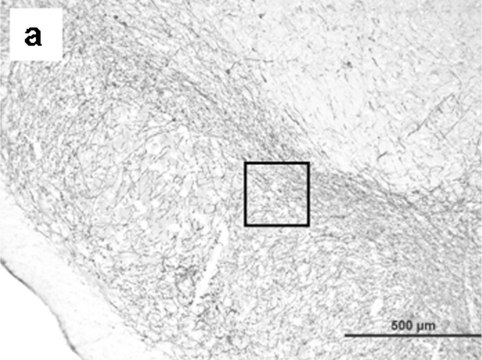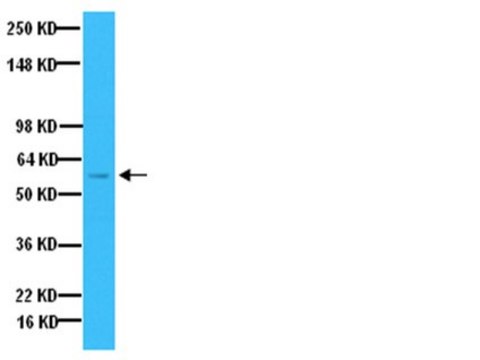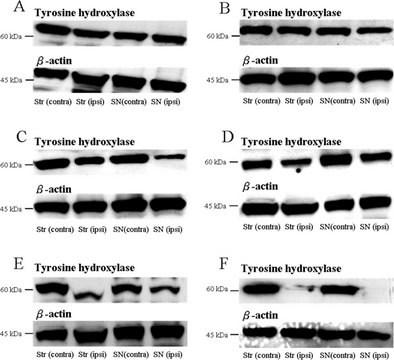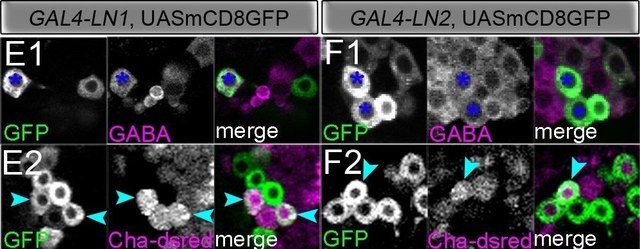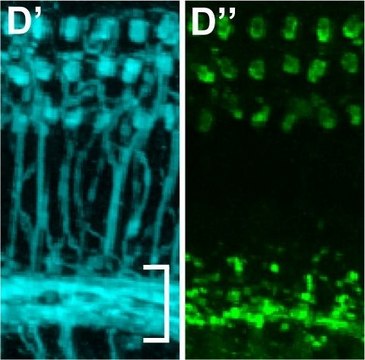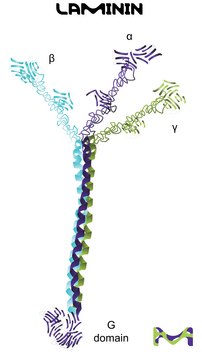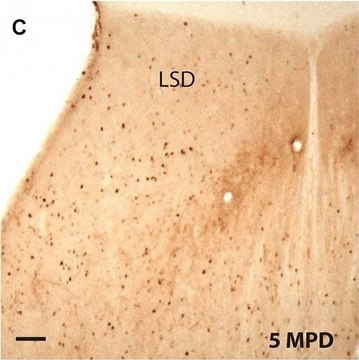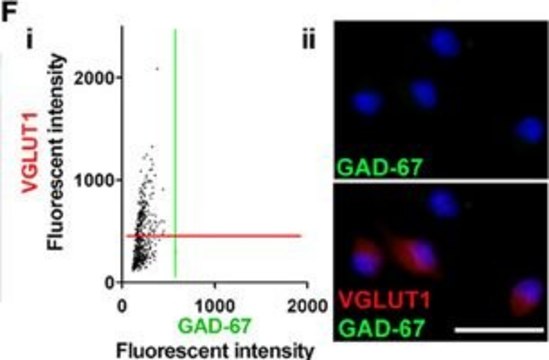AB9702
Anti-Tyrosine Hydroxylase Antibody
Chemicon®, from chicken
Sign Into View Organizational & Contract Pricing
All Photos(1)
Synonym(s):
TH
UNSPSC Code:
12352203
eCl@ss:
32160702
NACRES:
NA.41
Recommended Products
biological source
chicken
Quality Level
antibody form
affinity purified immunoglobulin
antibody product type
primary antibodies
clone
polyclonal
purified by
affinity chromatography
species reactivity
human, mouse
manufacturer/tradename
Chemicon®
technique(s)
immunocytochemistry: suitable
immunohistochemistry: suitable
western blot: suitable
isotype
IgY
NCBI accession no.
UniProt accession no.
shipped in
wet ice
target post-translational modification
unmodified
Gene Information
human ... TH(7054)
Specificity
Recognizes Tyrosine Hydroxylase
Immunogen
Synthetic peptides from human/mouse Tyrosine Hydroxylase
Application
Anti-Tyrosine Hydroxylase Antibody is an antibody against Tyrosine Hydroxylase for use in IC, IH & WB.
Immunohistochemistry: 1:1000-1:2000 using 2% paraformaldehyde fixed tissues.
Immunocytochemistry: 1:1000-1:2000 using 2% paraformaldehyde fixed cells.
Western Blotting: 1:2000-1:5000
Optimal working dilutions must be determined by the end user.
Immunocytochemistry: 1:1000-1:2000 using 2% paraformaldehyde fixed cells.
Western Blotting: 1:2000-1:5000
Optimal working dilutions must be determined by the end user.
Research Category
Neuroscience
Neuroscience
Research Sub Category
Neurotransmitters & Receptors
Neuronal & Glial Markers
Neurotransmitters & Receptors
Neuronal & Glial Markers
Physical form
Affinity purified chicken IgY. Two different antibodies were combined to make this product. Liquid in PBS, pH 7.2 with 0.02% sodium azide.
Storage and Stability
Maintain at 2-8°C in undiluted aliquots for up to 6 months after date of receipt.
Legal Information
CHEMICON is a registered trademark of Merck KGaA, Darmstadt, Germany
Disclaimer
Unless otherwise stated in our catalog or other company documentation accompanying the product(s), our products are intended for research use only and are not to be used for any other purpose, which includes but is not limited to, unauthorized commercial uses, in vitro diagnostic uses, ex vivo or in vivo therapeutic uses or any type of consumption or application to humans or animals.
recommended
WGK
WGK 2
Flash Point(F)
Not applicable
Flash Point(C)
Not applicable
Certificates of Analysis (COA)
Search for Certificates of Analysis (COA) by entering the products Lot/Batch Number. Lot and Batch Numbers can be found on a product’s label following the words ‘Lot’ or ‘Batch’.
Already Own This Product?
Find documentation for the products that you have recently purchased in the Document Library.
Antonella Meloni et al.
The Journal of clinical endocrinology and metabolism, 104(1), 150-162 (2018-10-20)
In autoimmune polyendocrinopathy-candidiasis-ectodermal dystrophy (APECED), autoantibodies (AutoAbs) labeling brain neurons were reported; conversely, brain MRI alterations associated with these AutoAbs were never reported. To describe brain alterations in APECED and to correlate them with AutoAbs against glutamic acid decarboxylase (GAD)
Florian Groessl et al.
Nature neuroscience, 21(7), 952-962 (2018-06-29)
Functional neuroanatomy of Pavlovian fear has identified neuronal circuits and synapses associating conditioned stimuli with aversive events. Hebbian plasticity within these networks requires additional reinforcement to store particularly salient experiences into long-term memory. Here we have identified a circuit that
Laura Angioni et al.
Hormones and behavior, 83, 23-38 (2016-05-18)
Oxytocin is involved in the control of different behaviors, from sexual behavior and food consumption to empathy, social and affective behaviors. An imbalance of central oxytocinergic neurotransmission has been also associated with different mental pathologies, from depression, anxiety and anorexia/bulimia
Ryan M Grippo et al.
Current biology : CB, 27(16), 2465-2475 (2017-08-07)
Dopamine (DA) neurotransmission controls behaviors important for survival, including voluntary movement, reward processing, and detection of salient events, such as food or mate availability. Dopaminergic tone also influences circadian physiology and behavior. Although the evolutionary significance of this input is
Thomas Andreska et al.
The Journal of neuroscience : the official journal of the Society for Neuroscience, 40(33), 6289-6308 (2020-07-12)
Motor learning depends on synaptic plasticity between corticostriatal projections and striatal medium spiny neurons. Retrograde tracing from the dorsolateral striatum reveals that both layer II/III and V neurons in the motor cortex express BDNF as a potential regulator of plasticity
Our team of scientists has experience in all areas of research including Life Science, Material Science, Chemical Synthesis, Chromatography, Analytical and many others.
Contact Technical Service